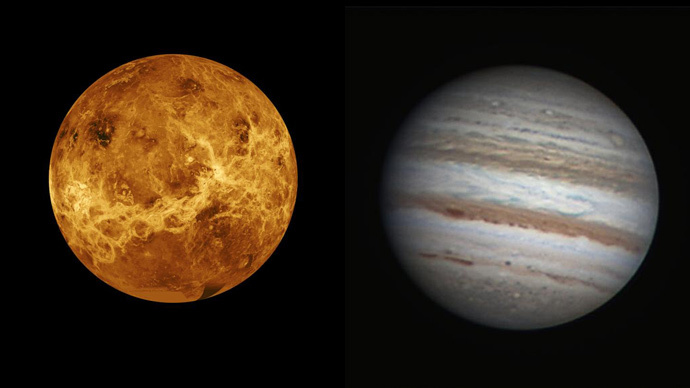Venus & Jupiter to pair in spectacular 'Star of Bethlehem' conjunction

The two brightest planets Venus and Jupiter are to appear so close in the sky in the upcoming nights that they will be seen like a single super bright star, which some astronomy-lovers say resembles the biblical 'Star of Bethlehem'.
“Throughout the month of June 2015, the two brightest planets in the night sky, Venus and Jupiter, are going to converge for a close jaw-dropping encounter,”said NASA in a news release.
During the whole month the planets were drawing closer to each
other and on June 30 they will reach their tightest grouping. In
fact every night in June, the separation between the celestial
bodies was visibly shrinking.
“On that night [June 30] Venus and Jupiter will be a … 1/3rd
of a degree apart. That's less than the diameter of a full moon.
You'll be able to hide the pair not just behind the palm of your
outstretched hand, but behind your little pinky finger,”
added NASA.
READ MORE: Jupiter destroyed solar system’s young planets, scientists say
#perth if you look west at sunset and evening and see a bright star, its Jupiter and Venus at conjunction @tweetperthpic.twitter.com/CpScNb7zW8
— Perth Observatory (@perthobs) June 30, 2015
Such a celestial event, when two celestial bodies have either the same right ascension or the same ecliptic longitude, while observed from Earth, is called a conjunction.
Next week, watch Venus and Jupiter high-five each other in the night sky http://t.co/lbArdxKiUcpic.twitter.com/wyVw38epcA
— Popular Science (@PopSci) June 27, 2015
Sky &Telescope astronomy magazine suggested that the event closely resembles the Star of Bethlehem which, according to Christian tradition, revealed the birth of Jesus to the Biblical Magi, and later led them to Bethlehem.
"As has been the case in 2014–15," Sky & Telescope contributor Fred Schaaf said, "the first two conjunctions back then were extremely close, the last one separated by about 1°, all three occurred not far from Regulus, and all were similarly high up in the sky."
When Jupiter met Venus. Not often you can see a sight like this! Can you see Jupiter’s moons? #conjunction#Dunedinpic.twitter.com/5OmHzJAUMB
— Ian Griffin (@iangriffin) June 30, 2015
According to Nick Howes, an astronomer working with the Kielder Observatory in Northumberland, Jupiter which orbits in 4,330 days would appear circular, while Venus which orbits in only 225 will be seen as a crescent.
“The angular separation between the two planets will be so small that the tip of your little finger at arm’s length will cover it,” he told MailOnline, “To see it you'll need a clear west-northwest horizon, and it will be spectacular in small telescopes and larger binoculars as you'll get to see the phase of Venus as well as the moons and major gas bands of Jupiter as well.”
Venus and Jupiter by Stephen Rahn @stephenrahn13https://t.co/qFk3MUZzwe
— Global Star Party (@globalstarparty) June 30, 2015
Venus, the second planet from the sun, is 93 million km from Earth, while Jupiter, the fifth planet from the sun and the largest planet in the solar system, is much farther, at 909 million km.
Conjonction entre les planètes Jupiter & Venus..Bonne soirée et avis de passage d'étoiles filantes :p #Boulet2canonpic.twitter.com/iqH5M8STQe
— Ad astra Ad solis (@AdastraAdsolis) June 30, 2015
Very cloudy tonight for conjunction of Venus and Jupiter , got a couple of shots, #Venus#Jupiter#Hawerapic.twitter.com/6f0F1DvnvF
— Francis Panton (@foreverfalcon) June 30, 2015
Ayer mientras me tomaba un helado pude ver una imagen maravillosa, júpiter y Venus juntos!! #fbpic.twitter.com/gUWe6lEgNr
— Carlos Fernández (@Charly280392) June 30, 2015












